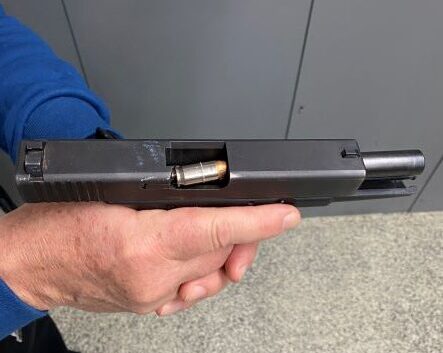
By Michael A. Black | Contributing Editor
I’m looking forward with great anticipation to attending the upcoming Shot Show next January, especially Industry Day at the Range, where those lucky enough to qualify get to fire a bunch of guns at the Boulder Range, near Boulder City.
The show was cancelled in 2020 due to the pandemic, but I have good memories of being on there in 2019. Shooting stations are set up along the expansive range, there’s plenty of ammunition, and the shooting lines are long. Consequently, the guns are fired pretty much non-stop all day and this increases the chance that the build-up of powder might cause a jam up in the semi-auto pistols.
Now, in fairness to the old revolver vs. semi-auto jamming debate, I need to point out that this powder build-up can adversely affect both types of weapons, but most of the time it may cause a jamming malfunction in the semi-autos. Thus, if you carry a semi-auto, you should know how to clear a weapon malfunction should you need to do so.
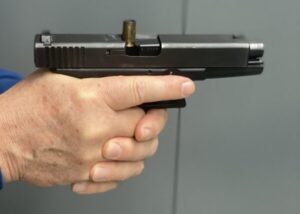
Back in the day, I was a newly promoted sergeant attending a training class at the Chicago Police Academy. I’d been a police officer for a while and was allowed to attend in civilian clothes, thus I wore my off-duty gun, a Smith & Wesson Model 39 9mm semi-auto. A couple of cadets came up to me and asked if my weapon ever jammed. At that time a lot of police carried revolvers. I assured them that if they kept the ramp clean, a jam-up would be rare. My experience carrying various semi-autos bore this out. I always kept my weapons clean and well-maintained, and never experienced a jam, which is not to say that I didn’t train for one. In a tense situation, the way you train is the way you react. You should train for every eventuality, even if the possibility of something going awry is not likely. Remember our buddy, Murphy and his infallible law: “Whatever can go wrong, will go wrong.” (I usually like to add “And it’ll go wrong at the worst possible moment.”)
Now, getting back to my experience at Industry Day at the Range in 2019. I was on the firing line at one of the booths shooting a semi-auto nine millimeter. (I’m not going to say which, because as I mentioned, these guns were being fired constantly and at this time were very dirty.) I experienced a jam-up. The weapon ejected the spent shell casing, and then, as the slide went forward to chamber the next round, the bullet didn’t feed correctly, thus taking the weapon out of battery. I’d trained for this situation over the years so I automatically cleared the malfunction, chambered a new round, and continued to fire. The range master at my station was impressed that I knew how to do this.
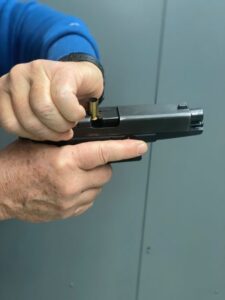
“Retired cop,” I told him. “We used to train for this.”
He nodded. “Good move.”
Now I’m not trying to pat myself on the back here. I’m merely stating the obvious. You should train for every eventuality, including safely drawing your gun, shooting from various positions, and clearing all malfunctions.
So let’s go over the basics of clearing a jam.
Again, let me preface this section by saying if you are diligent about caring for and cleaning your gun after each usage, you probably won’t have to worry about jamming. But train for every eventuality, like perhaps accidentally dropping your weapon in a mud puddle and then having to use it.
The basics of clearing a jam in a semi-automatic pistol are simple. The jam-up occurs after the first fired round. The slide is sent backward by the gases and the extractor ejects the spent shell casing through the ejection port. The slide’s backward movement is then stopped, and it is propelled forward by the spring, chambering the next round in the magazine. If the ramp that guides this next round up into the chamber is corrupted by dirt or excessive powder, it may not feed correctly and not travel up into the chamber.
This is called a misalignment. The way to clear this is known as “tap and rack.” Use your non-dominant hand to tap the bottom of the magazine, assuring it’s properly seated within the weapon. Then, also using your non-dominant hand, grip the ribbed lines on the end of the slide and rack the slide back. This should allow the extractor to clear any obstructed shell casing that has not fully ejected. As you do this, tilt the weapon to the right to facilitate the ejection of the shell casing. I recommend tilting in this direction because the ejection port is on the right side of the slide.
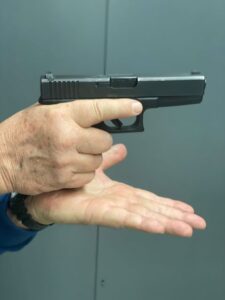
I was taught in the army to cup my non-dominant hand behind the ejection port of the Colt 1911 Government Model and grip the slide with forefinger and thumb to rack it back. “This will shield your eyes should any leftover powder ignite.” (I’d never heard of this happening, but I wasn’t going to argue with the Drill Sergeant.) Either way, this action should be done quickly and without hesitation. After completing it, release the slide allowing it to chamber a new round, resume your non-dominant hand grip, and fire the next round.
Another rare problem that may occur is known as a stovepipe. In this case the spent shell casing does not fully eject and the slide catches before it can fully exit the ejection port. This snared shell casing resembles the chimney of an old stove as it’s held in place by the slide. The procedure for clearing this malfunction is basically the same. Rack the slide back and let it snap forward. A quick rightward thrust of the weapon will assist in removing the snared shell casing. You should be ready to fire at this point.
If for some reason you can’t, do the tap and rack procedure once again. There’s a possibility that the next round in the magazine might not have fed correctly. Thus, you might be ejecting an unfired round, but one of the benefits of having a high capacity magazine is you mostly likely will have enough rounds left to finish the job.
An aside here: despite the ridiculous criticism by some people who are ignorant of guns and how they work, i.e., “Why did the shooter have to fire all those rounds?” You should keep firing, judiciously of course, until the threat is stopped. Worry about explaining why later.
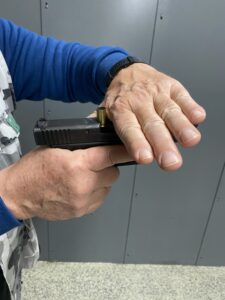
One more cautionary note before we wrap things up. Be careful when you’re cleaning the slide of your semi-auto. You should never hold it vertically, with the chambered end down, and scrub the breechblock plate where the firing pin or striker hits the primer of the cartridge. Over time, cleaning fluid can seep down into the chamber and coagulate, impeding the proper functioning of the firing pin or striker. So keep the muzzle end of that slide pointed down during cleaning.
As I previously mentioned, most likely your weapon won’t jam if it’s kept clean and in good working order, but train for every eventuality.
My friend on CPD used to call this drill “Tap, rack, and bang.” It was later modified to “Tap, rack, and reassess,” in case something changed downrange. Whatever you call it, remember, the way you train is the way you’ll react. One way to train for the unexpected is to have your training partner load your magazine for you, placing some dummy rounds in the stack. That way you won’t know when, or if, a malfunction is coming.
And if you do get one, remember, tap and rack. Don’t let our buddy Murphy ruin your day.



